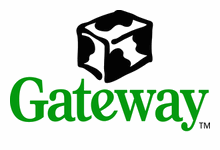This one is from W.H. Auden:
We are here on Earth to do good to others. What the others are here for, I don’t know.
This one is from W.H. Auden:
We are here on Earth to do good to others. What the others are here for, I don’t know.
 Clearing out a filing cabinet today, we came across the documentation for an old Gateway machine. (Remember them? They were the Dell of the time.) It was actually rather a good 66 Mhz Pentium, which I bought in 1994, chiefly to write up my PhD thesis.
Clearing out a filing cabinet today, we came across the documentation for an old Gateway machine. (Remember them? They were the Dell of the time.) It was actually rather a good 66 Mhz Pentium, which I bought in 1994, chiefly to write up my PhD thesis.
Amongst the documentation was an index card on which I’d written the IRQ settings and I/O addresses of all the peripheral cards – the sound card, the modem, the SCSI adaptor, the CD-ROM interface card… all of these settings I’d had to tweak by hand, usually by installing little jumper connectors on the cards themselves. You had to make sure no two devices were using the same settings; I’d disabled the joystick interface on the soundblaster card to reduce the likelihood of his happening. It’s all a procedure for which I feel very little nostalgia.
At the time, I really liked this big, clunky, noisy system, with its 15″ CRT monitor, but it cost me £2260.71 – well over £3000 quid in today’s money. Or, to put it another way, for the same price I could now buy three MacBook Airs.
I guess we have made some progress after all…
Amsterdam Central Station last night.

 A confession. I’ve gone over to the dark side.
A confession. I’ve gone over to the dark side.
No, I’m not using Windows again – it’s not that bad. But I have started doing something which, until fairly recently, I considered far from commendable.
Yes, you’ve guessed it. I’ve started sending HTML-formatted email.
I used to be a purist. Email was for textual communication, and didn’t need frivolous formatting, so all my email programs were told in no uncertain terms that outgoing email should be plain text only. There were all those nasty privacy and security issues, especially in early versions of Outlook and Outlook Express. Javascript and ActiveX could be embedded in messages, exploiting security holes in the receiving mail program. Senders could include an image in an email which would be loaded when the message was viewed, meaning they could detect whether you’ve looked at it or not! Shocking, eh?
Well, maybe, but the security holes have largely been fixed, spam filters take out most of the stuff I would have worried about, notification systems are decidedly fallible and most email clients let you switch all these features off if you’re still concerned.
I really have no desire to change my background colours or embed YouTube videos in my messages. But in the end I decided that in the 21st century it was just plain silly not to be able to write sub-headings in bold or emphasise things with italics.
I was being a luddite. I was effectively insisting that all letters should be word-processed in a monospaced font because that had been good enough for typewriters. That wasn’t the way to make progress. I was using more sophisticated formatting in my instant messaging than in my carefully-composed emails! Yes, there are some potential issues, but denying myself from using italics was not the way to get those issues fixed. Anyway, the rest of the world was ignoring people like me. I’ve been getting an awful lot of formatted emails for an awfully long time, and never had any problems.
Actually, I would have made the switch earlier, but it’s only with the latest (Leopard) version that Apple’s Mail app – which I rather like – has really adopted HTML as its standard formatting – before that it could happily display incoming HTML but used richtext for outgoing compositions; something that not all other programs could read very well. Fortunately, any well-behaved email program will send a plain-text version of any message alongside a formatted one, so the important text should still get through.
Which means that if you wish to read my emails as if they came off a typewriter, you can still do so. I’m afraid neither the presence nor the absence of formatting is likely to improve the content!
I met this splendid chap on a walk today. From the look of his hooves he must be at least part Shire (I’m no expert). Very friendly, very gentle, and very tall. He looked down upon me from a great height. I’m about 6ft and I didn’t crouch down at all to take this one.

George Bernard Shaw’s epitaph:
I knew if I waited around long enough something like this would happen.
Sorry things have been fairly quiet here of late. I’ve reached a sort of email event horizon where messages that require action or response are arriving faster than I can act or respond to them. After that you go into a kind of tailspin…
The quotation, by the way, is from C.S.Lewis. For your contemplation.
This post is here purely to help those who are Googling for a solution to this problem. Everyone else please ignore!
 If you have an HP all-in-one 3300-series printer/copier/scanner, and it starts saying “Scanner error power off->power on”, but powering off and on doesn’t help, then you really need this page. Many thanks to all who posted there!
If you have an HP all-in-one 3300-series printer/copier/scanner, and it starts saying “Scanner error power off->power on”, but powering off and on doesn’t help, then you really need this page. Many thanks to all who posted there!
Basically, you power off the printer and unscrew the screw which allows you to remove the small piece of glass to the left of the main scanning glass.
Using some needle-nosed pliers through the opening, grasp the drive belt and use it to move the scanning head across from the right hand side of the scanning area to the left, until it’s right under the opening. At the bottom of the wide slot, there’s a mirror, and it gets fogged up with something.
Shine a good light in there and use dry Q-tips to give the mirror a good clean. Then reassemble everything and turn the printer back on. After a little warm-up, you should get the ‘Ready’ prompt again, and your heart will be filled with joy.
The whole process should only take about 5 mins. There may be other things which cause a ‘scanner error’, but this fixed it for me and, it would appear, for many others.
The origin of this is unknown but I came across it in the documentation for some project-management software:
One cannot bring a baby into the world in one month by getting nine women pregnant at the same time.
 One of the things Steve Jobs announced in his latest keynote was a drop in the price of the AppleTV, from $299 to $229 for the base model.
One of the things Steve Jobs announced in his latest keynote was a drop in the price of the AppleTV, from $299 to $229 for the base model.
This should be good news for us at CamVine, because we buy quite a few of these – we take them apart and do nefarious things with them.
But there’s no price drop in the UK market – in fact, they’re still selling at £199. Now that’s not a bad price overall, and you have to remember that UK prices include 17.5% tax, but it’s still nearly $400 – substantially more even than the old price.
The price drop in the US, of course, coincided with the availability of movie rentals from the iTunes Music Store – something not available in other parts of the world yet. I wonder if the US hardware is being subsidised at all by the rental business?
They’re very nice devices, but I don’t have one at home because, some time ago, I bought a Mac Mini to go beside my TV, and an Elgato EyeTV box to capture digital broadcasts. It does everything the AppleTV does and a lot more – playing DVDs, for one thing. At the time, it seemed like quite an extravagance. But I’ve never regretted it for a moment. The vast majority of our TV watching is done this way now, and the recent release of a new version of the EyeTV software just makes it better.
I wrote before about Garrison Keillor’s News from Lake Wobegon. This regular feature of his Prairie Home Companion show is available as a weekly podcast here.
The Jan 5th episode was a very good one, I think, and if you’re not familiar with GK’s genius, I recommend grabbing the MP3 file.
The acquisition of XenSource by Citrix a few months ago was a powerful example, and yesterday Sun announced that they will be paying $1B for MySQL, which many people thought might have an IPO this year.
It’s a surprise, but I think Sun will probably be good guardians of what has become one of the most important Open Source projects.
© Copyright Quentin Stafford-Fraser
Recent Comments